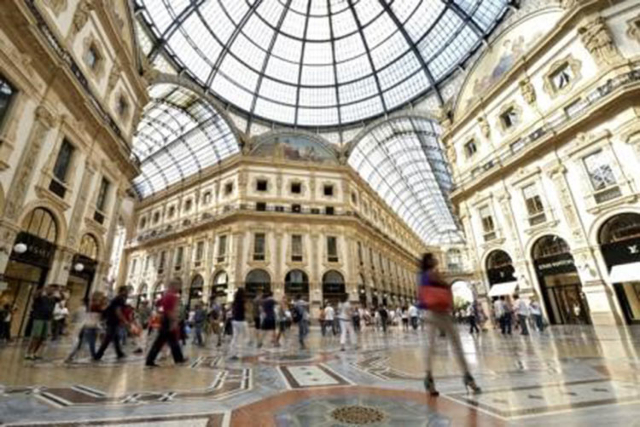Milan experiencing a renaissance, thanks to World Fair

MILAN — Long the ugly sister to Florence, Venice and Rome, Italy’s business capital Milan is enjoying a renaissance, its once drab skyline coming to life and a new creative vibrancy emerging.
Host of the 2015 Expo, Milan has taken advantage of the World Fair to rejuvenate its image, attracting new investment in a makeover that officials hope might mark the start of a broader revival for the whole country.
The sleek headquarters of Italian bank Unicredit, the centerpiece of one of several new developments that dot the northern city, is a state-of-the-art reminder of Milan’s status as a financial hub.
And while the gothic Duomo cathedral and Galleria shopping arcade recall past glories, modern ventures — such as the “Vertical Forest” apartment blocks whose balconies bloom with trees and plants — point to a newfound confidence.
Milan has absorbed more than half of all investment in business real estate in Italy in the first half of this year, while tourism has grown faster over the past six years than in Italy’s other big cities.
“The majority of what I heard about Milan was that it’s industrial, not a beautiful city, but the Duomo and the Galleria are really grand,” said visitor Cameron Dibb, 24, an American film student who lives in Surrey, England.
“And when you go further outside the center the architecture is still impressive,” he added.
Despite appearances, Milan is not immune from Italy’s bureaucracy, corruption and weak economic growth.
Unadjusted gross domestic product per capita in the Lombardy region around Milan fell 1.4 percent between 2008 and 2013 and the once powerful industrial hinterland has been battered by competition from China.
But other areas suffered far worse after the European debt crisis and Milan seems to have regained its drive, unlike scandal-plagued Rome.
“Rome is very dirty and badly looked after, it hardly seems like a capital city. Milan would have been a better capital,” said Vicente Perez, 52, a tourist from Madrid.
A leisure tourism city
Next to the Duomo, the glass-vaulted Galleria has been cleaned up in a project co-funded by luxury firms Prada and Versace and publisher Feltrinelli in the sort of public-private partnership that Italy is increasingly relying on to safeguard its crumbling heritage.
The Galleria restoration was finished in time for the Expo, a six-month showcase for products and technology from around the world that Prime Minister Matteo Renzi has shown off to an array of global leaders.
Cost overruns, delays and graft overshadowed the start of the fair, but city governor for tourism Franco D’Alfonso said ticket sales are on track to reach between 18 million and an original target of more than 20 million.
Some businesses in the city center are nonetheless unhappy, saying their trade has been cannibalized by Expo, which lies on the outskirts, and by some 184 new bars, restaurants and ice cream shops which have opened over the last 18 months.
“Expo has taken people out of town and they opened loads of bars so the slice of the cake for each business has got smaller and smaller,” said 40 year-old bar owner Gianni Pugliese.
But many are celebrating the overall rise in tourism, which began well before Expo, with the number of overnight visitors increasing 34 percent between 2009 and 2014, based on data from Euromonitor International, versus a 21 percent rise for Rome.
The global financial crisis cost the city business tourists, said Maurizio Naro, president of hoteliers association APAM, and it has had to adapt to a new type of visitor.
“Milan has turned into a leisure tourism city in the last 10 years exactly to face up to the sharp slump in business tourism,” he said.
The corporate side might also finally be stirring.
Milan soaked up 59 percent of all investments in business real estate in Italy in the first half of this year, including some 900 million euros ($1.02 billion) from the Qatari sovereign wealth fund, according to BNP Paribas Real Estate.
“(The city) is seen around the world as the symbol of a serious, active and productive Italy,” said veteran fashion designer Giorgio Armani, who has opened a four-story exhibition space for his designs, to coincide with Expo.
Demand for office space has picked up in the past year and prime rents now appear to have bottomed out after tumbling since 2011, according to property consultants Knight Frank.
From swamp to oasis
The promise of Expo-related visitors and international attention galvanized long-awaited improvements to the city, notably the trendy but scruffy canal area where a new waterside promenade opened in May.
Simone Bracaglia, 30, a human resources consultant who runs a bar on the main inlet, says takings have risen at least 20 percent since the “Darsena” — or dock — reopened.
“It used to be a swamp … now it’s an oasis”, Bracaglia said. The boom in business “is definitely not down to our skills but the sheer number of people, thanks to this blessed Darsena.”
A revival is also underway on the south-eastern periphery, where the Rem Koolhaas-designed Prada Foundation complex, housing modern art, classical sculpture and a 1950s-themed bar conceived by film director Wes Anderson, also opened in May.
“I have always known this area as a bit of a ghetto so it’s a big change. We aren’t used to having these great spaces in Milan,” said Amelia Corigliano, a 42-year-old social worker.